Parts of A Giant Sequoia Tree
All giant sequoia trees
have three major parts: roots, a trunk and leaves.
Other important parts
of a tree are the bark and burls. In this section of the tour, you
will learn about these parts and how they all work together to
help keep the tree alive and healthy.
Click on any
photo to see an enlargement.
The Roots
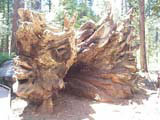 Here are the roots of a giant sequoia that fell and died. Roots are the
part of the tree that grow underground and take water and nutrients
from the soil. Notice how shallow, or short, the roots are. The
roots only reach six to eight feet straight down, which is not
very far for such a large tree. Instead, the roots grow sideways
under the surface of the soil. This means that the roots can drink
water from the ground even if it rains only a little bit. Sequoias
get most of their water from melted snow.
Here are the roots of a giant sequoia that fell and died. Roots are the
part of the tree that grow underground and take water and nutrients
from the soil. Notice how shallow, or short, the roots are. The
roots only reach six to eight feet straight down, which is not
very far for such a large tree. Instead, the roots grow sideways
under the surface of the soil. This means that the roots can drink
water from the ground even if it rains only a little bit. Sequoias
get most of their water from melted snow.
top
The Trunk
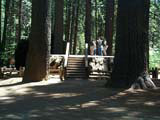 In the distance you can see a platform where people
are standing. Look more closely - the platform is actually the
sawed-off trunk of a giant sequoia tree! Try to imagine
how large this tree must have been before it was cut down in the
year 1853. People in those days had never seen a giant sequoia,
and were so excited about the trees that they stripped the bark
off this one and cut it down. They took the parts of the tree
to different cities, where they put it back together to make it
look like a live tree. They wanted to share the tree with people
who had never seen a giant sequoia. In the park, they used to
use base of the trunk as a dance floor. What do you think about
doing something like that today?
In the distance you can see a platform where people
are standing. Look more closely - the platform is actually the
sawed-off trunk of a giant sequoia tree! Try to imagine
how large this tree must have been before it was cut down in the
year 1853. People in those days had never seen a giant sequoia,
and were so excited about the trees that they stripped the bark
off this one and cut it down. They took the parts of the tree
to different cities, where they put it back together to make it
look like a live tree. They wanted to share the tree with people
who had never seen a giant sequoia. In the park, they used to
use base of the trunk as a dance floor. What do you think about
doing something like that today?
top
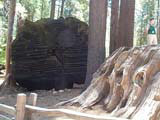 Here is part of the trunk of the same
tree in the background. It is lying on its side and you are looking
at the cross section. Look at the man standing on the right side.
Can you get an idea of how large across the trunk is?
Here is part of the trunk of the same
tree in the background. It is lying on its side and you are looking
at the cross section. Look at the man standing on the right side.
Can you get an idea of how large across the trunk is?
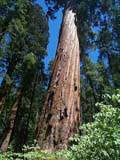 Look closely at this tree. Do you notice
anything about the pattern in its trunk? The trunk is growing
in a spiral or twisting pattern. The spiral growth allows
the tree to be more flexible. This means that the tree won't fall
down in a strong wind or heavy snowstorm as easily as a tree that
has a straight trunk. This is one way that giant sequoias are
adapted to their environment.
Look closely at this tree. Do you notice
anything about the pattern in its trunk? The trunk is growing
in a spiral or twisting pattern. The spiral growth allows
the tree to be more flexible. This means that the tree won't fall
down in a strong wind or heavy snowstorm as easily as a tree that
has a straight trunk. This is one way that giant sequoias are
adapted to their environment.
top
The Leaves
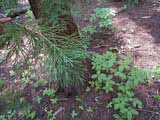 The leaves on a giant sequoia tree are short
and prickly.They overlap each other and help protect the tree.
The leaves on a plant are green because they have chlorophyll (KLOR-uh-fihl) in them. Chlorophyll
is what makes food out of sunlight for the plant. The giant sequoia
leaves do this same thing for the tree.
The leaves on a giant sequoia tree are short
and prickly.They overlap each other and help protect the tree.
The leaves on a plant are green because they have chlorophyll (KLOR-uh-fihl) in them. Chlorophyll
is what makes food out of sunlight for the plant. The giant sequoia
leaves do this same thing for the tree.
top
The Bark
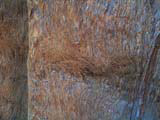 Take closer look at the bark of this giant sequoia. Bark is the outer layer of
wood on a tree. The bark of sequoia trees are very spongy, soft,
and thick. The bark on a giant sequoia tree can grow to be two
feet thick! This helps to protect the sequoia from very hot summer
days or very cold winter days. This is another way that giant
sequoias are adapted to their environment.
Take closer look at the bark of this giant sequoia. Bark is the outer layer of
wood on a tree. The bark of sequoia trees are very spongy, soft,
and thick. The bark on a giant sequoia tree can grow to be two
feet thick! This helps to protect the sequoia from very hot summer
days or very cold winter days. This is another way that giant
sequoias are adapted to their environment.
Animals of the forest have
learned to use the bark from giant sequoias. Tree squirrels and
birds tear off small strips of the bark to use in their nests.
Ants chew tunnels in the bark to make shelter for their young.
top
The Burls
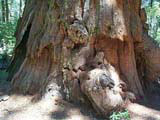 Do you see the large growths or bumps on the trunk
of this giant sequoia? They are called 'burls.' The giant sequoia tree grows these burls in response
to disease or injury. The burls usually form at the base of the
tree.
Do you see the large growths or bumps on the trunk
of this giant sequoia? They are called 'burls.' The giant sequoia tree grows these burls in response
to disease or injury. The burls usually form at the base of the
tree.
top

Continue the tour!
Introduction
Life Cycle of
A Giant Sequoia
Fire Resistance
Other Plants
of the Giant Sequoia Forest
Glossary
Try the Word
Search!
Take the Quiz!
top
 Here are the roots of a giant sequoia that fell and died. Roots are the
part of the tree that grow underground and take water and nutrients
from the soil. Notice how shallow, or short, the roots are. The
roots only reach six to eight feet straight down, which is not
very far for such a large tree. Instead, the roots grow sideways
under the surface of the soil. This means that the roots can drink
water from the ground even if it rains only a little bit. Sequoias
get most of their water from melted snow.
Here are the roots of a giant sequoia that fell and died. Roots are the
part of the tree that grow underground and take water and nutrients
from the soil. Notice how shallow, or short, the roots are. The
roots only reach six to eight feet straight down, which is not
very far for such a large tree. Instead, the roots grow sideways
under the surface of the soil. This means that the roots can drink
water from the ground even if it rains only a little bit. Sequoias
get most of their water from melted snow.




